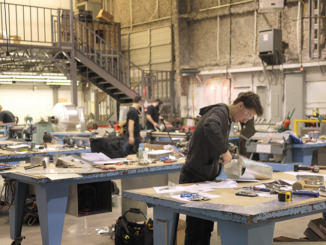
As 2020 dawns, the construction outlook is fairly stable, with spending up marginally and a trade dispute affecting manufacturing across the country. On the brightest side, women are taking up positions in trade-related professions at breakneck speed. Sheet Metal Journal-Western Washington has compiled the following construction outlook based on numbers in November and December 2019, sources from Reuters, Associated Press, Business Insider, and other public news releases. Be sure to watch these pages and www.sheetmetaljournal.com for updates moving forward into the year.
Construction dollars up at the end of 2019
U.S. construction spending ticked up just 0.1% in July, aided by government spending on schools, sewers, and the water supply.
The Commerce Department said in November that spending on construction projects in July occurred at a seasonally adjusted annual pace of $1.29 trillion. So far this year, construction spending has tumbled 2.1%, dragged down by a sharp pullback in expenditures for homebuilding.
Construction for single-family houses picked up 1.4% in July, a possible response to lower mortgage rates. But private spending on the building of apartments, lodging, and commercial spaces fell. Overall, private construction spending slipped 0.1%
Government spending accounted for July’s increase, as construction spending rose 0.4%. State and local governments accounted for most of the gains as spending on school construction rose. But federal construction spending fell 2.4%.
U.S. manufacturing contracts as trade war with China bites
U.S. manufacturing activity contracted for the first time in three years in August, with new orders and hiring declining sharply as trade tensions weighed on business confidence, raising financial market fears of a recession.
Concerns about the economy, which is in its longest expansion ever, were also exacerbated by other data showing construction spending barely rising in July. The reports somewhat offset upbeat data on consumer spending that had suggested that while the economy was slowing, it was not losing momentum as rapidly as financial markets were flagging.
“The canary in the mine may be falling off its perch,” said Joel Naroff, chief economist at Naroff Economic Advisors in Holland, Pennsylvania. “With manufacturing now starting to contract, it is even more critical that the consumer keeps spending.”
The Institute for Supply Management (ISM) said its index of national factory activity dropped to a reading of 49.1 from 51.2 in July. A reading below 50 indicates contraction in the manufacturing sector, which accounts for about 12% of the U.S. economy. November marked the first time since August 2016 that the index broke below the 50 threshold.
August’s reading was also the lowest since January 2016 and was the fifth straight monthly decline in the index. The United States now joins the euro zone, Japan, the United Kingdom, and China, which have long been experiencing a contraction in factory activity.
Still, the ISM index remains above the 43 level, which economists associate with a recession. The U.S.-China trade tensions also coincide with diminishing stimulus from last year’s $1.5 trillion tax cut package.
The ISM said there had been “a notable decrease in business confidence,” adding that “trade remains the most significant issue, indicated by the strong contraction in new export orders.” Economists polled by Reuters had forecast the ISM index would slip to 51.0 in August.
The U.S.-China trade fight is eroding business sentiment, with business investment contracting in the second quarter for the first time in more than three years. That, together with an inventory bloat, is undercutting manufacturing, with output declining for two straight quarters.
Consumers have largely shrugged off the trade dispute and continued to spend, propping up the economy. But that could change with the trade war spilling over to shopping malls.
A new round of U.S. tariffs on imports of Chinese goods, mostly consumer products like clothing, footwear and televisions, took effect on Sept. 1. Additional U.S. tariffs are due to be imposed in December.
With trade tensions simmering in the background, the Federal Reserve is expected to cut interest rates again this month to keep the economic expansion, now in its 11th year, on track.
The Fed lowered its short-term interest rate by 25 basis points in July for the first time since 2008, citing trade tensions and slowing global growth. Financial markets have fully priced in another quarter-percentage-point cut at the Fed’s Sept. 17-18 policy meeting.
U.S. Treasury prices rose on the factory data, with the yield in the benchmark 10-year note dropping to its lowest since July 2016. The Treasury yield curve has inverted, signaling that a recession is looming. Stocks on Wall Street fell, while the dollar was little changed against a basket of currencies.
Women in trades
Women still aren’t paid as much as men in America — they make $0.79 for every dollar men make in 2019. While that gap has been steadily decreasing in recent years, women are getting more jobs in traditionally male-dominated fields. According to a new study by financial services company SmartAsset, some of the fastest-growing jobs for women are in construction, engineering, and ride-hailing services. The study used data from the Bureau of Labor Statistics (BLS) from 2014-2018.
The fastest-growing job category is taxi drivers and chauffeurs, due to ride-hailing platforms like Uber and Lyft. There have been 394,000 more drivers — both male and female — on the road from 2014-2018. The second-fastest growing industry is construction: In the last five years, there was an 85% increase in construction jobs for women. Many jobs on the list are in STEM fields such as engineering, computer science, and healthcare.
In November 2019, Business Insider compiled a list of 25 professions typically sought by a men but experiencing an uptick of interest from the female workforce. Of these, seven are related to construction:
25. Construction and maintenance painters saw a 30% growth in employment between 2014 and 2018.
Women employed in 2014: 33,700
Women employed in 2018: 43,700
23. Freight, stock, and material movers and laborers saw a 32% growth in employment between 2014 and 2018.
Women employed in 2014: 341,700
Women employed in 2018: 450,700
17. Mechanical engineers saw a 36% growth in employment between 2014 and 2018.
Women employed in 2014: 26,700
Women employed in 2018: 36,300
9. Construction managers saw a 49% growth in employment between 2014 and 2018.
Women employed in 2014: 52,600
Women employed in 2018: 78,600
6. Architects (except naval) saw a 58% growth in employment between 2014 and 2018.
Women employed in 2014: 45,000
Women employed in 2018: 71,000
3. Industrial engineers, including health and safety, saw an 82% growth in employment between 2014 and 2018.
Women employed in 2014: 31,000
Women employed in 2018: 56,600
2. Construction laborers saw an 85% growth in employment between 2014 and 2018.
Women employed in 2014: 42,200
Women employed in 2018: 78,100
Reporting by Lucia Mutikani; Editing by Paul Simao, Reuters; Associated Press; and Business Insider.



